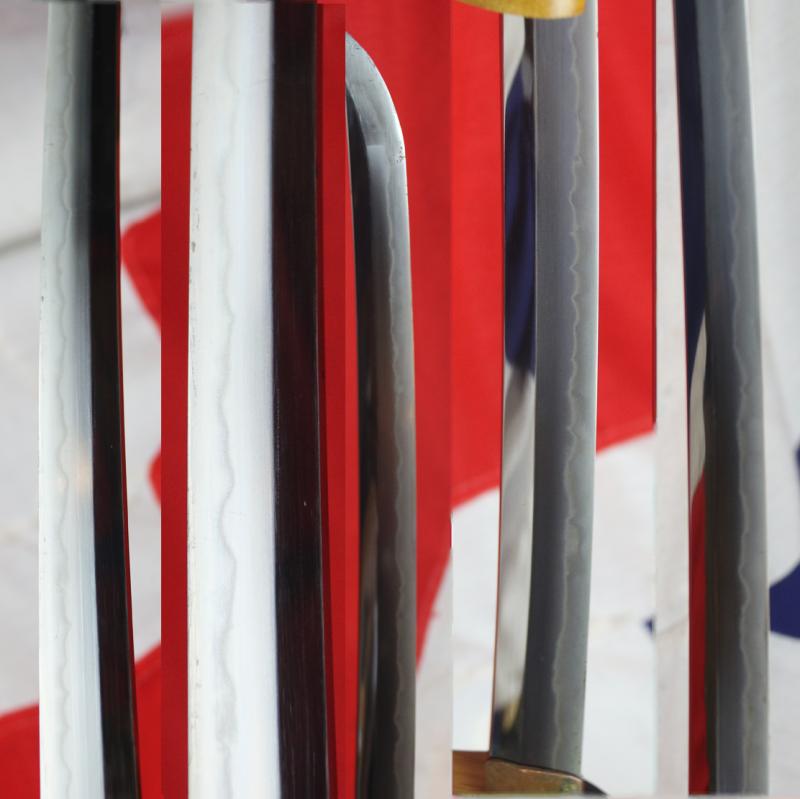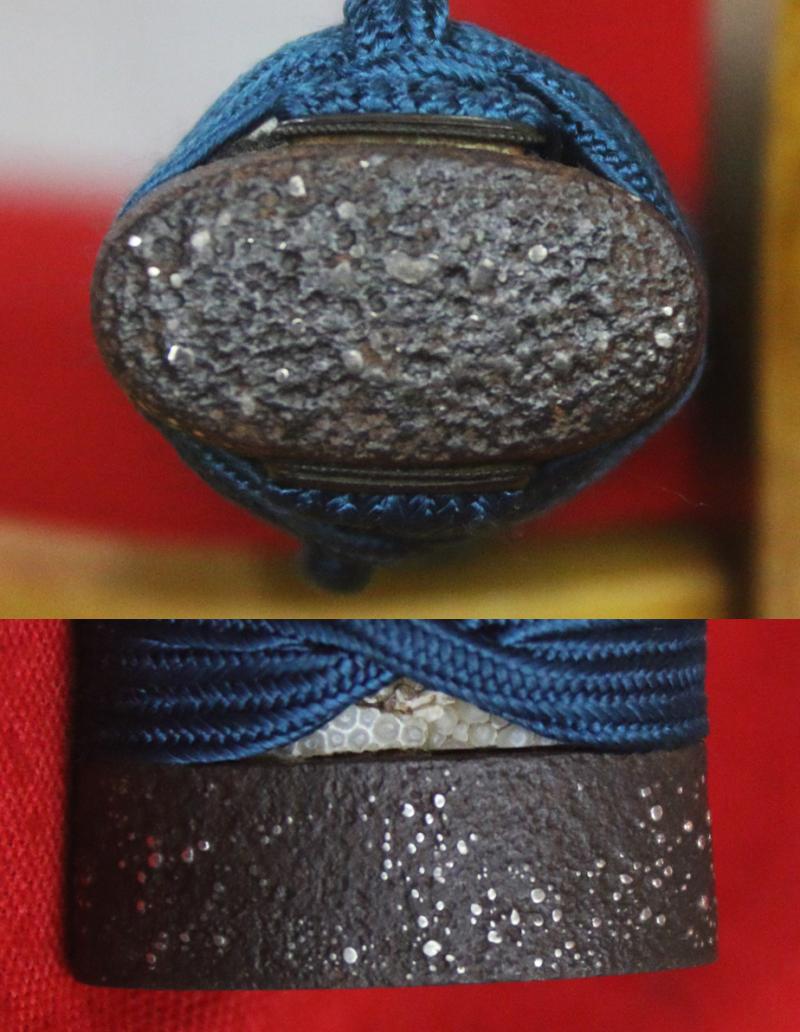A Fine & Most Beautiful Japanese Katana, Signed Mitsuhiro Saku Late Koto to Shinto Period
A very attractive samurai katana, around 400 to 450 years old in a superb colour livery of blue-green tsuka-ito and a two colour saya of brown ishime {stone finish} and bright black urushi ribbed lacquer to the top quarter section, bound with white sageo, and a polished carved buffalo horn kurigata and sayajiri. The blade is signed, Mitsuhiro and shows a beautiful gunome hamon. The pair of menuki are a pair of caught Warasubo spine toothed fish, one with a mouse foraging on the top of its body. The mud flats of Japan’s Ariake Sea are home to a creature that is reportedly as delicious as it is disgusting-looking. Introducing the “Warasubo”, an eel-like xenomorph goby fish that for obvious reasons is known as the “Alien of Ariake Sea”, found in a large bay in Kyushu,
The fuchi kashira tsuka fittings are a pair of Edo period iron Higo school inset with silver droplets either representing a heavenly constellation, or snowflakes falling at night.
Made and used in the time of the greatest battle in samurai history. The Battle of Sekigahara Sekigahara no Tatakai) was a decisive battle on October 21, 1600 that preceded the establishment of the Tokugawa shogunate. Initially, Tokugawa's eastern army had 75,000 men, while Ishida's western army numbered 120,000. Tokugawa had also sneaked in a supply of arquebuses. Knowing that Tokugawa was heading towards Osaka, Ishida decided to abandon his positions and marched to Sekigahara. Even though the Western forces had tremendous tactical advantages, Tokugawa had already been in contact with many daimyo in the Western Army for months, promising them land and leniency after the battle should they switch sides.
Tokugawa's forces started the battle when Fukushima Masanori, the leader of the advance guard, charged north from Tokugawa's left flank along the Fuji River against the Western Army's right centre. The ground was still muddy from the previous day's rain, so the conflict there devolved into something more primal. Tokugawa then ordered attacks from his right and his centre against the Western Army's left in order to support Fukushima's attack.
This left the Western Army's centre unscathed, so Ishida ordered this unit under the command of Shimazu Yoshihiro to reinforce his right flank. Shimazu refused as daimyos of the day only listened to respected commanders, which Ishida was not.
Recent scholarship by Professor Yoshiji Yamasaki of Toho University has indicated that the Mori faction had reached a secret agreement with the Tokugawa two weeks earlier, pledging neutrality at the decisive battle in exchange for a guarantee of territorial preservation, and was a strategic decision on Mori Terumoto's part that later backfired.
Fukushima's attack was slowly gaining ground, but this came at the cost of exposing their flank to attack from across the Fuji River by Otani Yoshitsugu, who took advantage of this opportunity. Just past Otani's forces were those of Kobayakawa Hideaki on Mount Matsuo.
Kobayakawa was one of the daimyos that had been courted by Tokugawa. Even though he had agreed to defect to Tokugawa's side, in the actual battle he was hesitant and remained neutral. As the battle grew more intense, Tokugawa finally ordered arquebuses to fire at Kobayakawa's position on Mount Matsuo to force Kobayakawa to make his choice. At that point Kobayakawa joined the battle as a member of the Eastern Army. His forces charged ?tani's position, which did not end well for Kobayakawa. Otani's forces had dry gunpowder, so they opened fire on the turncoats, making the charge of 16,000 men mostly ineffective. However, he was already engaging forces under the command of Todo Takatora, Kyogoku Takatsugu, and Oda Yuraku when Kobayakawa charged. At this point, the buffer Otani established was outnumbered. Seeing this, Western Army generals Wakisaka Yasuharu, Ogawa Suketada, Akaza Naoyasu, and Kutsuki Mototsuna switched sides, turning the tide of battle
The top section of the blade, near the kissaki has two very small areas of natural age pitting
Code: 25237
5950.00 GBP










